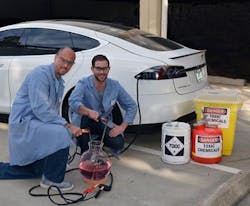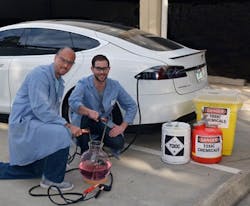Electricity Boosts Allylic Oxidations
Electrochemistry provides a better way to perform allylic oxidation reactions, contend researchers from The Scripps Research Institute (TSRI), La Jolla, Calif. The method relies on inexpensive, safe chemicals instead of the toxic or expensive metal oxidants or mediators used conventionally, and is innately scalable, operationally simple and environmentally friendly, they note.
Figure 1. Phil Baran (left) and Evan Horn use electricity (but not actually from the Tesla car pictured) to power an allylic oxidation reaction. Source: The Scripps Research Institute.
In collaboration with pharmaceutical chemists at Bristol-Myers Squibb, New Brunswick, N.J., and Asymchem Life Science, Tianjin, China, Phil Baran, a chemistry professor at TSRI, and his team used the method to produce more than 40 compounds, including over a dozen terpenes — promising materials for making pharmaceuticals as well as flavors and fragrances. In nearly all the reactions, the electrochemical approach’s advantages — better yields as well as safer and cheaper reagents — were striking, claim the researchers. In addition, the electrochemical allylic oxidations boasted dramatically better environmental footprints than conventional syntheses.
“The scope of the reaction is just phenomenal; it’s super easy to do, and the overall improvement in environmental sustainability is dramatic,” says Baran. The researchers believe their approach may open up opportunities for allylic oxidation reactions, which up until now generally have been restricted to small-scale applications because of the toxicity or cost of reagents.
[javascriptSnippet ]
The reaction system uses widely available materials: tert-butyl hydroperoxide acts as the oxidant, while inexpensive pyridine and acetone serve as the base and solvent, respectively. The electrochemical mediator, which enhances the replacement of hydrogen by oxygen, is derived in one step from a nontoxic, cheap and widely available flame retardant. Trials relied on vitreous carbon electrodes, which cost just a few dollars each, with electricity coming from a simple battery. Chemists at Asymchem ran one test on the 100-g scale using a hardware-store bucket as the reaction vessel.
More details on the technique appear in an article in the journal Nature.
“We encourage any groups or companies interested in using the method to do so,” notes Evan Horn, a member of the TSRI team. “We have already been contacted by a number of other pharmaceutical, fine chemical, and fragrance companies with questions about the transformation, etc., so, hopefully, people will be using it soon.
The researchers themselves aren’t planning to scale up the technology. “Right now, we have shifted our focus to developing other useful electrochemical transformations, both oxidative and reductive methods. We can’t go into detail, but the power of electrochemistry is huge, both for enabling new reactivities that are not possible using conventional stoichiometric reagents, as well as the significant improvement in cost and environmental impact,” says Horn.

